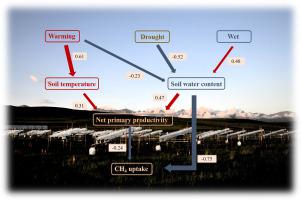Applied Soil Ecology ( IF 4.8 ) Pub Date : 2021-05-19 , DOI: 10.1016/j.apsoil.2021.104061 Zhenhua Zhang , Guangshuai Wang , Hao Wang , Qi Qi , Yunfeng Yang , Jin-Sheng He

|
Alpine meadows are significant CH4 sink. However, the response of soil CH4 uptake to future climate change in the alpine meadows remains poorly understood. We carried out an alpine meadow field experiments to determine how warming and altered precipitation (drought and wetness) affect CH4 uptake, as well as its underlying mechanisms. Our results showed that this mesic alpine meadow was a CH4 sink under all treatments (ranging from −311.4 to −487.1 mg m−2 CH4). Warming significantly increased CH4 uptake by an average of 18.14% of the annual cumulative CH4 uptake and by 48.68% of the non-growing season cumulative CH4 uptake. Drought enhanced the positive warming effect on CH4 uptake by decreasing soil water content, but wetness weakened this effect. Moreover, using high-throughput sequencing and GeoChip approaches, we found that warming stimulated CH4 uptake not only by increasing CH4 oxidation but also by decreasing CH4 production through changing the methanotroph community compositional structure. Further analysis revealed that the dynamics of daily CH4 uptake were mainly regulated by soil water content during the growing season, whereas daily CH4 uptake was strongly correlated with soil temperature during the non-growing season. Warming and altered precipitation influence soil CH4 uptake in different ways during the growing and non-growing seasons. Based on our results, we predict that Tibetan Plateau mesic alpine meadows will remain a net sink of CH4 under future climate warming and drought scenarios, but soil CH4 uptake will decrease if precipitation increases in future.
中文翻译:

青藏高原高寒草甸变暖和干旱加剧,但湿润减少了CH 4的净汇
高寒草甸是重要的CH 4汇。但是,对于高寒草甸土壤CH 4吸收对未来气候变化的响应仍然知之甚少。我们进行了高山草甸田间试验,以确定变暖和降水变化(干旱和潮湿)如何影响CH 4吸收及其潜在机理。我们的结果表明,在所有处理下(从-311.4到-487.1 mg m -2 CH 4),该内陆高山草甸都是CH 4汇。气候变暖显着增加了CH 4的吸收,平均每年累积的CH 4吸收量为18.14%,非生长季节的累积CH 4的平均吸收量为48.68%。摄取。干旱通过降低土壤含水量增强了对CH 4吸收的正向增暖作用,但湿度减弱了这种影响。此外,使用高通量测序和GeoChip方法,我们发现变暖不仅通过增加CH 4氧化来刺激CH 4吸收,而且通过改变甲烷营养生物群落组成结构来降低CH 4产生。进一步的分析表明,在生长季节,每天摄入的CH 4的动态主要受土壤水分的调节,而在非生长季节,每天摄入的CH 4与土壤温度密切相关。变暖和降水变化对土壤CH的影响4在生长季节和非生长季节以不同的方式摄取。根据我们的结果,我们预测在未来的气候变暖和干旱的情况下,青藏高原的中生高山草甸将仍然是CH 4的净汇,但是如果将来降水增加,土壤CH 4的吸收将减少。



























 京公网安备 11010802027423号
京公网安备 11010802027423号